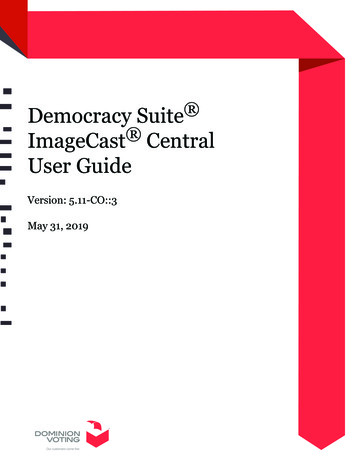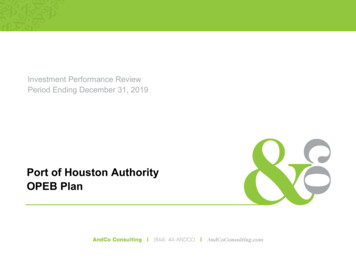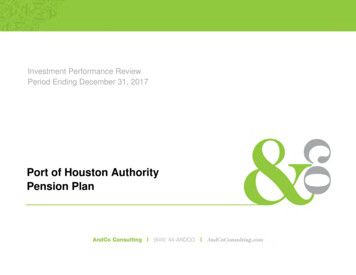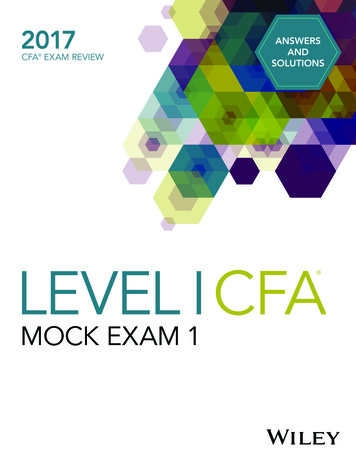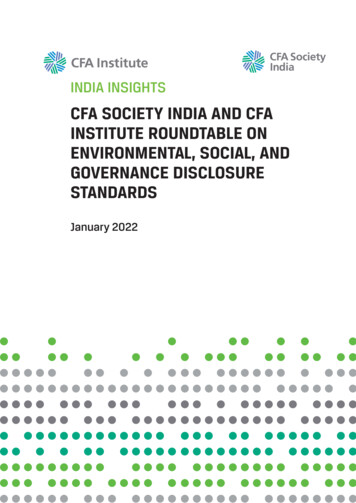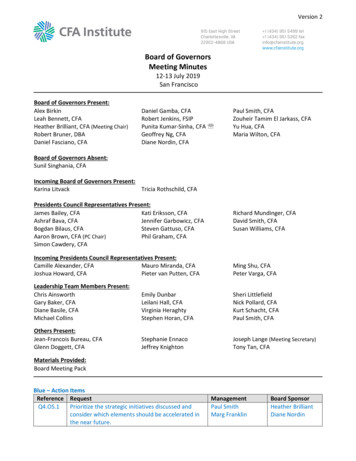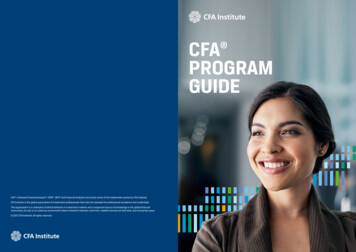
Transcription
IASB/FASB JOINT MEETING OCTOBER 2009APPENDIX B TO AGENDA PAPER 7ACFA Institute Member Poll:Cash Flow SurveyJuly 2009
Background to SurveyA direct method cash flow statement would include cash inflows and cash outflows from operating activities(e.g., cash from customers, cash paid to suppliers, etc.). That information is not available when operating cashflows are presented indirectly (net income is reconciled to operating cash flows).The Boards are trying to get an understanding of how useful for corporate valuation and risk analysis the"direct" information about operating cash flows would be. This is on the assumption that if a direct methodwere to be required, information about operating cash flows currently provided by the indirect method wouldcontinue to be required either on the face or in the notes (as required by FASB Statement 95 today). That is, areconciliation of net income (or operating income) to operating cash flows would be provided in the financialstatements (as a complement to the direct method cash flow statement).It is also important for the Boards to understand the advantages/disadvantages to users of the additionaloperating cash flow information and the relative usefulness of such information contained in the direct versusindirect cash flow statement, so as to evaluate the cost-benefit of the requirement.To that end, as part of financial statement presentation improvements, the IASB and FASB are consideringrequiring all companies to present information about cash flows from operating activities using a direct methodin the statement of cash flows (most companies currently only use an indirect method). This survey aims to helpthe Boards understand the extent to which users would benefit from the additional operating cash flowinformation presented in a direct method cash flow statement.Purpose and MethodologyThe purpose of this poll was to obtain CFA Institute member feedback on issues related to cash flows fromoperating activities and their presentation in direct and indirect method cash flow statements.The eight question survey was e-mailed to a sample of 12,050 CFA Institute members on 16 July 2009, and thesurvey closed on 24 July. Members were selected based on professional demographics, including occupationand topics of interest. The sample targeted members that chose both a targeted occupation (AcademicAccounting, Accountant/Auditor, Actuary, Appraiser, Corporate Financial Analyst, Credit Analyst, InvestmentBanking Analyst, Portfolio Manager, Research Analyst, or Treasurer) and indicated financial statement analysisas an area of interest.The total number of eligible responses was 541, for a response rate of 4.5 percent. The confidence interval is 4.1 percent at the 95 percent confidence level. Margin of error varies by question as the number responding toeach question varies. The response rate is slightly less than what we have seen from other related surveys to asample of members (although only 1 to 2 percentage points lower); however, there was no reminder sent forthis survey due to the quick turnaround (just over one week to respond) and response is often lower in July dueto holiday and vacation time. The number of responses is more than sufficient for reliable analysis andreporting.CFA Institute Centre SurveyCash Flow Survey (July 2009)Proposed U.S. Regulatory Reform Survey (June/July 2009)Executive Compensation Survey (May 2009)Short Selling Survey (May 2009)Eligible Responses54118379131417Response Rate5%7%6%7%2
Credit Rating Agency Survey (April 2009)Earnings Guidance Survey (March 2008)Corporate Disclosure Survey (October 2007)XBRL Survey (June 2007)CFA Centre Financial Reporting - Measurement (January 2007)1,18611339168685926%7%7%9%8%Survey analysis was conducted at the aggregate level as well as by industry, region, and occupation. Margin oferror is larger for subgroup analyses.3
ResultsDirect versus indirect information content29 percent of members strongly agreed that information about operating cash flows presented using the directmethod would better enable me to forecast future cash flows of an entity (compared to the indirect method)and 34 percent agreed. Further, 28 percent strongly agreed this information would be more useful in assessinga company’s quality of earnings compared to the indirect method and 35 agreed.Noteworthy subgroup differences: A higher proportion of corporate financial analysts strongly agree that information about operatingcash flows presented using the direct method would better enable them to forecast future cashflows of an entity compared to the indirect method (41 percent) than do portfolio managers,research analysts, and accountants/auditors (27%, 28%, and 23%, respectively). In addition, a higherproportion of industry generalists strongly agree (31 percent) than those specializing in the financialindustry (18 percent). A higher proportion of industry generalists strongly agree (14 percent) than those specializing in thefinancial industry (5 percent) that the information about operating cash flows presented using theindirect method enables me to assess a company’s quality of earnings. A higher proportion of industry generalists strongly agree (33 percent) than those specializing in thefinancial industry (20 percent) that information about operating cash flows presented using thedirect method would be more useful in assessing a company’s quality of earnings compared to theindirect method.4
Members indicated the most important information is cash revenue collections from core business activities (94percent rated as important or very important), working capital changes (91 percent), operating cash flowgenerated at segment and business subsidiary (83 percent), and expenses paid to suppliers (80 percent).Noteworthy subgroup differences: A higher proportion of investment banking analysts rated cash revenue collections from core businessactivities very important than did accountants/auditors (60 percent). Investment banking analysts alsorated expenses paid to suppliers (49 percent vs. 29 percent), working capital changes (72 percent vs. 34percent), and operating cash flow generated at segment and business subsidiary (48 percent vs. 25percent) more important than accountants/auditors. A higher proportion of members in the Asia Pacific and the United States rated cash revenue collectionsfor other business activities very important (22 percent and 19 percent, respectively) than did membersin Europe (9 percent). Generalists rated expenses paid to suppliers, cash flows from derivatives used to hedge forecast sales orpurchases, and working capital changes are more important than those specializing in other areas. Those in Africa, Middle East, and Latin America rated expenses paid to suppliers and cash flows fromderivatives used to hedge forecast sales or purchases most important of all regions (56 percent and 47percent rated as very important, respectively). Compared to corporate financial analysts, higher proportions of portfolio managers and researchanalysts indicated expenses paid to employees were very important (19 percent vs. 33 percent and 32percent, respectively).5
Of all occupations, investment banking analysts found working capital changes to be most important (72percent rated very important), followed by portfolio managers and research analysts (52 percent and 58percent, respectively), corporate financial analysts (45 percent), and accountants/auditors (34 percent). Higher proportions of research analysts, corporate financial analysts, and investment banking analystsrated operating cash flow generated at segment and business subsidiary as very important (48%, 43%,and 48%, respectively) than did accountants/auditors (25%).Other operating cash-flow related items members typically track in their analyses can be found in the Appendix.6
Direct method formatsIn addition to assessing direct versus indirect information content, there are two formats of direct method thatare under evaluation, one being more disaggregated than the other: Method 1: A direct method cash flow statement with cash inflows and outflows disaggregated by natureand function along with indirect information (more disaggregated) Method 2: A direct method cash flow statement with cash inflows and outflows aggregated at a higherlevel (more aggregated)71 percent of members said method 1 would provide sufficient information, while only 46 percent said method2 would provide sufficient information. 13 percent said method 1 would provide more information thanrequired. For method 1, 11 percent felt some of the lines in the example were unnecessary, and these lines canbe found listed in the Appendix. A higher proportion of members in Asia Pacific said method 1 would provide sufficient information (84percent) than did members in Europe and the United States (69 percent and 68 percent, respectively).Higher proportions in Asia Pacific also said method 1 would provide sufficient information (64 percent)than did members in Europe (38%), the United States (45%), and Africa/Middle East/Latin America (32percent).10 percent of responding members said there were other approaches to improving the cash flow statementsthat they would propose (open-ended comments available in the Appendix).7
AppendixCFA Institute Member Poll:Cash Flow Survey (July 2009)
Open-Ended CommentsMembers indicated the most important information is cash revenue collections from core business activities(94 percent rated as important or very important), working capital changes (91 percent), operating cash flowgenerated at segment and business subsidiary (83 percent), and expenses paid to suppliers (80 percent).Other operating cash-flow related items members typically track in their analyses include: A full reconciliation between net income and free cash flows A/R A/P Accruals and provisions are to a large extent operating in nature and should be considered in the cashflow analysis ("extended working capital"). Clearly also the cash impact of tax payments should not beneglected Actual cash taxes paid actual tax payment Adding direct method would be very helpful, but must ensure non-cash items disclosed in the indirectmethod still get disclosed well. affect of working capital, noncash charges, stock related expense Bank account balances and changes thereof. Capex CAPEX versus depreciation and maintenance versus explanation capex capex, taxes Capital expenditure Capital expenditure by segment would also be extremely useful. Capital Expenditures capital expenditures capital expenditures vs depreciation schedules; segment detail Capital expenditures, cash interest paid, debt issued and debt paid during the period. capital spending cash flow from assets, liabilities and capital Cash Flow from taxes and duties Cash Flow from royalties Cash Flow from leases cash flow on debt hedging (if possible to get it) pension payments for defined benefit and healthcareplans operating lease payments Cash flow related to tax payments Cash flows from regulatory assets and liabilities. [This is especially important for regulated industries likeutilities.] Cash flows on taxes and dividends (non-operating item though) using direct method will be useful Cash paid for inventory/raw materials. Cash paid out of balance sheet provisions (esp continental stocks) cash restructuring payments, cash pension contributions Cash taxes Cash taxes cash taxes paid Cash taxes paid versus tax accruals. Changes in deferred revenues, depreciation & amortization, stock-based comp.CFA Institute Member Poll:Cash Flow Survey (July 2009)
Changes in working capital accounts. Comparison of depreciation expense to capital expenditures.Analysis of maintenance cap ex vs. cap ex for business expansion. Necessity and ability to access capitalmarkets for additional debt or equity. Comparison of net income and operating cash flow; The ability to separate maintenance capex fromgrowth capex where possible d&a, D&A, cash interest, tax D&A, stock comp expense, changes in deferred revenue, changes in deferred taxes, non-recurring items,income from equity-method investments debt deferred taxes Deferred taxes and DDA Depreciation & Amortization depreciation and amortization expenses Depreciation and Other non-cash expenses Depreciation Share based compensation Deferred tax expense Depreciation, Amortization, one-time charges Detailed in- and outflows for items under working capital Differences between taxes reported and taxes paid Disclosure of factoring or similar transactions should be mandatory for all companies. Every standard must declare clearly the account classification in the cash flow statement to Adjustment,change in working capital, investing, financing and other (like foreign currency translation) Expenditure for capital goods Depreciation for banking - need to clearly identify interest income based on capitalized interest gross cash outflow to borrowers gross cash inflow from borrowers I look at the total picture -- the most important items vary from period to period I track funds from operations, prior to changes in non-cash working capital. Funds from operations aremore stable. Changes in non-cash working capital are volatile and not as useful in predictions. Thecurrent indirect system shows funds from ope I use a 'cash-basis' calculation that recreates cash line items to arrive at EBIDA (i.e. replace revenue withcash collections, COGS with cash to suppliers, and so on), which I use as net cash from operations. Then Isubtract capex (which can be adjusted Income taxes need cash flow disclosure given deferred income tax accounting. Maintenance vs growthspending should be distinguished. interest and taxes Interest expense and income Interest expenses, but only to the extent of potentially adjusting them out to financing cash flows (asappropriate). Interest paid Interest paid 2. taxes paid 3. contribution paid in provident fund and other similar promises like healthetc. 4. cash paid for direct inputs purchases, power/energy (depending on industry), marketing & sellingexpenses paid including comissions, interest paid, interest income earned, D&A breakout, specific working capital movements (AR, Inv, AP),income taxes paidCFA Institute Member Poll:Cash Flow Survey (July 2009)
Interest/dividends paid & received, taxes paid, purchase/sale of (intangible) fixed assets, purchase/ saleof investments (deposits, marketable securities &c), proceeds from/ redemptions of debt/securities,treasury stock purchases. interests paid Inventories in cyclical companies. Account Payables vs Account Receivables in retailers. Assets held forsale in restructuring companies. It is good to have notes explaining non-cash adjustment(s), such as FX gains/losses, on the cash flowstatement. It is helpful to be able to reconcile interest expense to cash interest paid and tax expense with taxes paid.It is also very important to segregate the effects of M&A transaction on changes in current assets andliabilities. It would also be helpful to It would be helpful to be able to see cash flow line items that match up with all the income statementand balance sheet categories so I can model better. lease expense More information is preferred to less. I'll take whatever I can get the company to disclose. Net use of provisions non cash-effective revaluations of investment properties; financial leases non-cash charges one time or very large income and expenses related to operating activity Operating lease expenses Payments into pension funds, payments related to litigation. Pension an benefit info. Details on taxes. Pension contributions, add-backs for non-cash restructuring, stock-option expense, bad debt expense pension/incentive plan cash expense should present in both method in order to have full picture Stock Based Compensation, Depreciation & Amortization, and Non-Cash Gains and Losses are the mostimportant. Tax paid Tax paid, Gratuity / End of Service Benefits for Employees, taxes Taxes paid The impact of cash taxes paid Working capital additions or reductions related to acquisitions or business disposals. Impact of foreignexchange on working capital items. I should as an analyst be able to reconcile the operating cash flowsto changes in the balance sheet and incomeCFA Institute Member Poll:Cash Flow Survey (July 2009)
In addition to assessing direct versus indirect information content, there are two formats of direct methodthat are under evaluation, one being more disaggregated than the other: Method 1: A direct method cash flow statement with cash inflows and outflows disaggregated bynature and function along with indirect information (more disaggregated) Method 2: A direct method cash flow statement with cash inflows and outflows aggregated at ahigher level (more aggregated)71 percent of members said method 1 would provide sufficient information, while only 46 percent saidmethod 2 would provide sufficient information. 13 percent said method 1 would provide more informationthan required.For method 1, 11 percent felt some of the lines in the example were unnecessary, including: All operating section details - excessive all sub-level lines; unnecessary - can't model that detailed Companies will argue that any particular line isn't necessary but I think they all are to get the clearestpicture. Cost detailing could be lower Detail of cash paid for goods and cash paid for selling activities. In aggregate, this detail is redundantwith the income statement cost of goods sold and sales and marketing expense. Detail regarding material, labor and overhead. direct lines ("Cash paid." lines) Don’t need the direct breakdown of the amount of cash paid for each individual line item, if its a concernyou can get at the numbers another way. Would add unnecessary detail to my models. Excessive detail in the sub-categories such as cash paid for general and administrative Excessive detail isn't worth cost of producing it I would require only the subtotals in the direct method. The extra layer of details would be tooburdensome to analyze, read, and forecast in most cases Illustration A - Operating CF is nearly a repetition of the income statement in cash paid for goods, need only materials and everything else. In general I believe disclosing this degree of detail may put public companies at a competitivedisadvantage to their nonpublic competitors. Indirect method is more reflective of maintainable cash flow Int exp on decommissioning Investing: purchase and sale of AfS Assets could be netted or just marked in a footnote next to "others" Investment activities are shown both above and below the Net Cash from Oper Activities. How docompanies make that distinction? Would prefer to see in one section. Is pension line true cash or accrual? If cash its OK if not delete it depends. but more is better than less It is a wonderful breakout, but for a company with multiple business lines or subsidiaries, it will proveunwieldy. Just leave things the indirect way. with direct details in a note litigation expenses, hedge settlements, overhead transport - too much detail. divisional breakdownsmore important Many of the expense and other components are subcategories on the balance sheet that we will neversee. This data does not improve balance sheet forecasting. Most of the detail, as immaterial.CFA Institute Member Poll:Cash Flow Survey (July 2009)
None of the lines using the direct method are actually forecastable.overhead - transport/overhead - other, advertising amounts paid,Practically all of them except the R&D and share based settlement lines - it's just a P&L on cash basisprefer current, indirect presentationPush back from companies as too much details for competitorsRevenues and expenses are more relevant to assess profitability than cash inflows and outflows. Cashflows are crucial to assess solvability and is less subject to accounting rules but can be manipulated justas much as revenues and expenses but simply diSale of receivablesale of receivable- more appropriate to disclosed in footnote rather than as a line item in a cash flowstatementSeparation of retail and wholesale customers seems highly artificial and discretionary in nature.Settlement of share based remuneration, settlement of cash flow hedge, available for sale financial assetline items,Shouldn’t capex be in investing, vs. operating cash flow section?take too long to dothe detailed breakout of cash flows between materials/labor/etc. is not only unnecessary, but I may notwant a company i am invested in disclosing that to their competitorsThe detailed cash cost components are rarely used for valuation purposes. The information can bederived from the P/L as long as depreciation and amortisation is reported in sufficient detail. I havenever, as an analyst made forecasts as detailed as aboveThe direct cash flow method is both unnecessary and obfuscatory. Dumping Companies' general ledgerinto the financial statements is not going to enhance reporting, it is just going to make financialstatements much longer and will bury the useful informThe entire direct method is potentially more confusing than helpful as it ignores accrual accounting. Forexample, assuming customers pay their bills 30 days after billing, what you show as "Cash collected fromcustomers" will include sales from the prithe format is not useful to understand cash flowThe indirect information would not be needed.The level of detail in operating is excessive, particularly in cash collections, cash paid for goods, and cashpaid for selling, which could all be settled into single line items (with advertising footnote disclosure).Also, the inclusion of capex and otthere are two lines for pension, unlikely both useful. Settlement of derivatives unlikely to be useful.Proceeds from issue of debt useless and should be in cash flow. Numerous redundant items in bothformats.to detailed information is not always better, information on that detailed level will most likely not becomparableToo many details on cash paid for goods and selling activities are excessive for forecast (but not forhistoric analysis)too many G&A categories; too many overhead categoriestoo much detail in statement of cash flow; it is a duplicate of P<oo much expense detail. It's difficult to easily determine working capital changes.too much infoCFA Institute Member Poll:Cash Flow Survey (July 2009)
10 percent of responding members said there were other approaches to improving the cash flow statementsthat they would propose: All i need is the second portion, just the indirect is fine. Apparently the Australians require direct method cf accounting but the companies admit that theyprovide it using an indirect method. I question the usefulness unless we are truly getting direct. balance-sheet-to-balance-sheet reconciliation Capex should be broken out between maintenance and growth. Interest should be reported as interestpaid on debt, interest paid on capital leases, interest received on cash & equivalents. Categories like operating and financing are often misused. Needs refinement. depends detail in deferred income Disallow aggregation so that for instance proceeds from the sale of fixed assets, and outlays forpurchases of fixed assets have to be shown separately. (cf Korea, DART disclosure in XML, unfortunatelyonly available in Korean); mandate a reconciliation o Do not use the direct method. It is useless and impossible to forecast, and too easy to manipulate. Enough details for the analyst to decide whether an item or a portion of it is recurring or nonrecurring,fixed or variable. Fact that you used two different companies to demonstrate two techniques makes it confusing. Shouldhave used same company with same numbers, just two different formats. EMC despite being a worseformat has a lot of useful info (e.g. minority interest, fixed versus variable, SG&A is generally not a useful concept fixed vs variable costs Format A format A format in the last ToolCo example was better hedges, incentive comp i like format a better -- more info I think the direct method would be useful for financial companies. Normally, I prefer to see the indirectmethod. I am concerned about the cost of compliance for the direct method - does it require two sets ofbooks - one for cash basis, another for acc If we stay with the current (indirect) format, I would advocate that companies be required to showinterim and cumulative CF statements. And then also disclose cash taxes/interest paid at the bottom ofthe CF statement as a supplemental disclosure. AMZ Improve Managements discussion and analysis, improve notes, if possible be more specific onmaintenance CAPEX and expansion. indirect Instead of starting with "net income" for the indirect cash flow, EBIT or EBITDA as starting point wouldgive the transparency on the Company's operating earnings in the CF statement. As taxes are dependenton the financing structure (level of debt) these Interest paid should be recorded as a financing cash flow just stick to the indirect method and give some supplemental info like R&D spending, share basedsettlement etc. keep existing indirect format keep indirect method; IT-Systems are not ready for direct cash flow; There will be to much guessing andexcel crunching to provide the figures Keep the indirect method, but require additional disclosure of key items.CFA Institute Member Poll:Cash Flow Survey (July 2009)
more less infoMore detailMore detail is better - aggregate numbers are uselessMore detail.More detailed breakdownmore detailed CFs allows better scrutiny of mgmt accruals/estimatesMore details regarding the Investing Cash Flow to get a better idea about how much of it is used asmaintenance CAPEX and how much is invested to finance future growthMove the details to the footnotes. It's possible to present too much information in the statements. Weneed to add the information as required footnotes.Moving finance related items out of Operating Cash Flows and into Financing Cash Flows (i.e. Interestpaid & Dividends paid) and, providing a lot more detail on Capex.Need to tie working capital changes to same line items as on balance sheet. Too often they do not matchup and it is difficult to reconcile.Need working capital movements, affects your Free Cash FlowNever use American format which starts at net level, this obscures information. Some of direct cash flowinformation useful but cost of preparation and analysis out of proportion to benefit gained.prefer the disaggregated approachCFA Institute Member Poll:Cash Flow Survey (July 2009)
CFA Institute Centre Survey Eligible Responses Response Rate Cash Flow Survey (July 2009) 541 5% . Executive Compensation Survey (May 2009) 913 6% Short Selling Survey (May 2009) 1417 7% . 3 Credit Rating Agency Survey (April 2009) 1,186 6% Earnings Guidance Survey (March 2008) 1133 7% Corporate Disclosure Survey (October 2007) 916 7%
